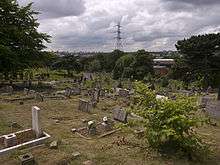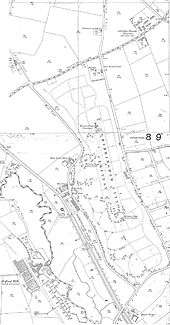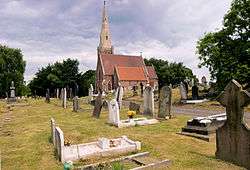Witton Cemetery
|
Chapel near the highest point | |
| Details | |
|---|---|
| Established | 1863 |
| Location | Birmingham |
| Country | England |
| Coordinates | 52°31′30″N 1°52′43″W / 52.5249°N 1.878697°WCoordinates: 52°31′30″N 1°52′43″W / 52.5249°N 1.878697°W |
| Owned by | Birmingham City Council |
| Website |
www |
| Find a Grave | Witton Cemetery |


Witton Cemetery (grid reference SP082921), which opened in Witton in 1863 as Birmingham City Cemetery, is the largest cemetery in Birmingham, England. Covering an area of 103 acres (0.42 km2), it once had three chapels; however, two of these were demolished in 1980. The cemetery would perform up to 20 burials a day; however, it was declared "full to capacity" in December 2013, allowing for burials only in existing family plots, or of babies or cremated remains.[1] Extra capacity was therefore provided at the nearby New Hall Cemetery.[1] The cemetery office was opened in 1999.
History
Started in May 1860 and consecrated by the Bishop of Worcester on 23 May 1863, it was the only cemetery owned by the Corporation of Birmingham until 1911, when an expansion of the city boundary brought in others.[2] Key Hill and Warstone Lane Cemetery were private concerns.[2] It opened in 1863 with an area of 106 acres (0.43 km2). In 1869, 2 acres (8,100 m2) were bought by the Jewish community for their own interments, [2] forming Birmingham Hebrew Congregation Cemetery, at the north of the site, across College Road.
The surrounding brick walls are 2 miles (3.2 km) long, the longest in the Midlands..
War graves
The cemetery contains 459 Commonwealth service war graves from World War I, over 200 of whom form three denominational war graves plots marked by Screen Walls bearing names of those buried within the plots and elsewhere in the cemetery whose graves could not be marked by headstones.[3]
There are 224 Commonwealth war graves from World War II, the greatest concentration (31 graves) in a small war graves plot in Sections 55 and 56, the rest are scattered individually in the rest of the cemetery. The names of 12 service personnel of that war whose graves could not be marked by CWGC headstones were added to the Screen Wall at the World War I plots.[3]
Notable individual graves
- Private George Ravenhill (1872–1921), VC winner Boer War. Grave currently (2012) unmarked.[4]
- William Snook, athlete (1861–1916). Died in workhouse hospital, his funeral paid for by former running club Birchfield Harriers.[5]
- Sergeant Arthur Vickers (1882–1944), VC winner First World War.[4]
- John Cadbury (12 August 1801 – 11 May 1889) was the proprietor of a small chocolate business in Birmingham, England, that later became Cadbury plc.
References
- 1 2 "Fears over chapel future as cemetery reaches capacity". Great Barr Observer. 28 February 2014.
- 1 2 3 In The Midst of Life - A History of the Burial Grounds of Birmingham, Joseph McKenna, Birmingham Library Services, 1992, ISBN 0-7093-0188-X
- 1 2 CWGC Cemetery report.
- 1 2 Burial Locations for VC Holders, city of Birmingham.
- ↑ Andrews, Harry (2008). The Follies of a Victorian Athlete (William Snook 1861-1916). Leonie Press (Anne Loader Publications). ISBN 978-1-901253-56-6.
External links
| Wikimedia Commons has media related to Witton Cemetery. |

